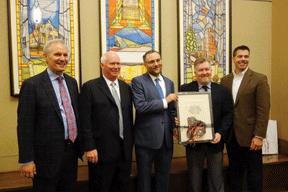
Four original paintings by Israeli artist Nahum Arbel were given back to Congregation Beth Shalom at a private event last Monday evening, Nov. 23. The paintings, found rolled up with the blueprints in a barrel in the basement of the former synagogue at 95th and Wornall, were discovered by Burns & McDonnell and Van Trust Real Estate prior to destruction of the building.
Burns & McDonnell Chairman and CEO Greg Graves and Van Trust President Dave Harrison officially re-presented them to senior Rabbi David Glickman and current President Norman Kahn.
Three of the paintings depict the long history of the synagogue. {mprestriction ids="1,3"}The first is of a Spanish Moorish design built in the early 1900s at 1425 Locust Street, when it was called Congregation Keneseth Israel.
The second is of the shul at 34th and Paseo dedicated in 1927, after Keneseth Israel and Beth Sholom merged. The Kansas City Star and Architectural League of Kansas City praised its beauty and architectural detail.
The third is a representation of the 95th and Wornall synagogue, which was built between the years 1962 (when the school building opened) and 1971 (when the sanctuary building opened). The new sanctuary included the Ark and stained glass windows from 34th and Paseo.
The history of Congregation Beth Shalom dates back to 1878.
According to Leslie Mark, an artist and congregant of Beth Shalom, Arbel’s paintings were all working sketches for the glass craftsmen to craft the stained glass windows.
“The fourth one in this batch has no connection that way whatsoever,” Mark said. “It’s a very classic, much heavier rendering of a representation of men at the Western Wall. So thematically and a little bit stylistically, it differs from the first three.
“I’m sure (Arbel) was commissioned to create these four and they were going to fit in with these more traditional, earlier-style windows that were being popped out from 34th and Paseo and being taken out to 95th and Wornall. These were commissioned to kind of document the momentous history of a growing congregation.”
She said some of the windows from Paseo have been installed at the new Lamar location, but assumes these four are still in storage along with many others. If and when a new sanctuary is built, the stored windows will be installed.
“Then these four will come out and the paintings will be matched up again with them,” Mark said.
The Arbel paintings will hang in the main foyer of the Lamar campus.
Mark said she first heard of the paintings when immediate Past President Mike Abrams called her. He said Jeff Turk who works at Van Trust had called him about them. Abrams was unaware of their importance so he called Mark because of her interest in the history of the shul and to view them with an artist’s eye.
“I went to see them because Mike called me and said, ‘Leslie, I don’t know if these are anything, but go and take a look.’ So I took a look and said, guess what — they’re something,” she said. “The amazing story is that someone saw them and did a little research and bothered to call. It was a neighborly thing to do.”
When she told Turk of the paintings’ significance, he said they would like to frame them. Mark and Turk met at Ward and Ward, a frame shop on 63rd Street, and with Tim Ward’s help, they picked out the framing. Mark said she also called Ellen Chilton, owner/operator of Pomegranate, Inc., and a congregant, to help pick out the frames.
Mark said the four paintings are in pristine condition even though they have been in a basement since the 1960s.
“It may actually speak to why they are in such good shape because they were put down in the basement in this barrel with the rolls of the architectural drawings and they never saw the light of day, so they weren’t in any way yellowed or cracked; they were in great shape,” she said.
Very little is known of painter/sculptor Arbel. He was born in 1926 in Tel Aviv. At some point he immigrated to the United States and died in 2010 in Charlotte, North Carolina, at age 83. He is one of the many prominent figures buried in Charlotte’s Hebrew Cemetery.
By the late ’50s and early ’60s, Arbel resided in Pennsylvania. Mark surmises the reason he was commissioned to do the paintings was his connection to Bernie Pucker, who owned the Pucker Safrai Gallery of Jerusalem and Boston. Pucker was no doubt familiar with Arbel’s work through his gallery.
“Beth Shalom of all the shuls in town is not one that has a long history of a diversion to art and artifacts and so on — they got some, but there wasn’t a guiding eye or an overarching principle,” Mark said.{/mprestriction}



